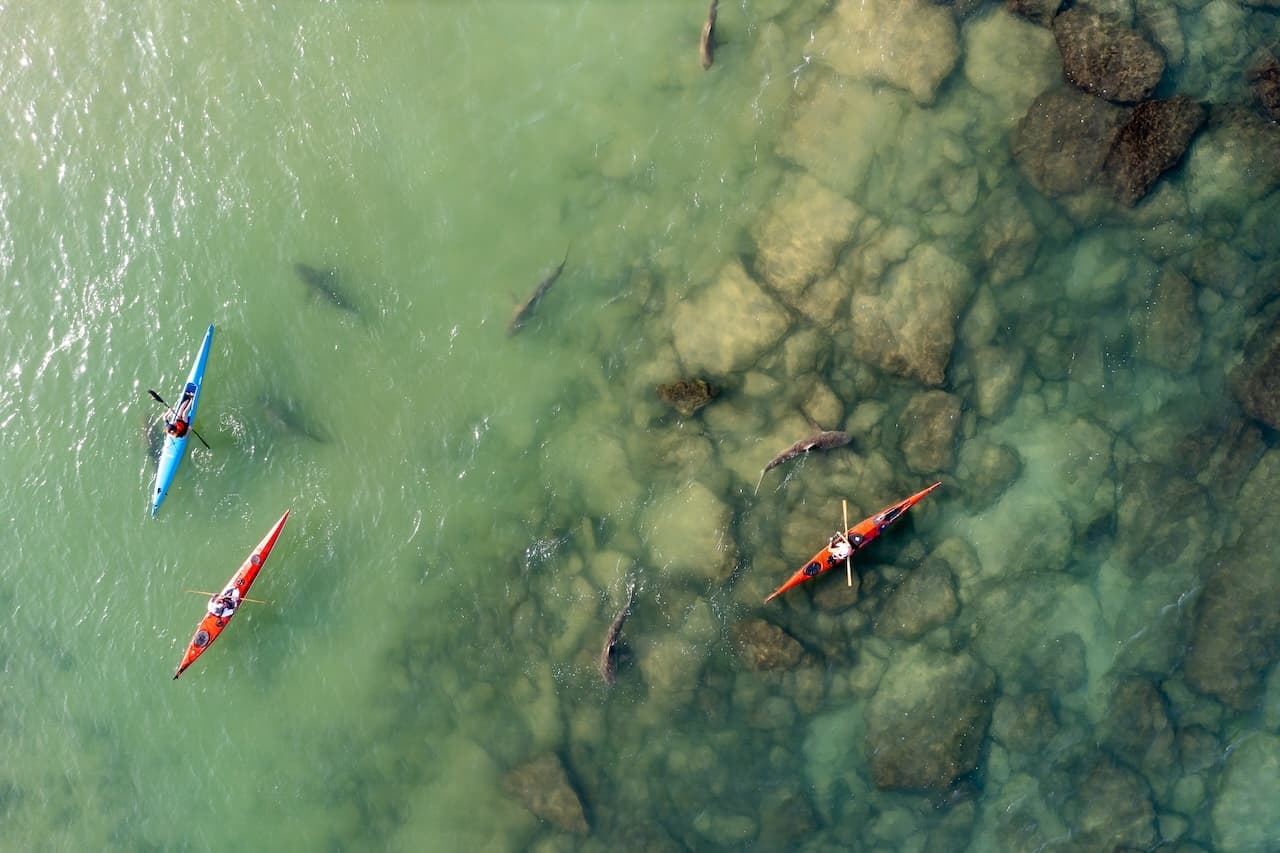What To Do When There’s A Shark Near Your Paddling Vessel
What To Do When There’s A Shark Near Your Paddling Vessel

When you’re paddling in salt water, there’s always a risk of a shark encounter. While these encounters are rare, they can be very unsettling when they happen. In some cases, a shark can even become curious or aggressive and come very close to your vessel. While this scenario is unlikely, it’s crucial you know how to react so you make all the right moves in the unlikely event of a shark encounter on the water.
When you encounter a shark in your paddling vessel, you must do your best to remain calm. Do not panic or cause any splashing, as this can make a shark more curious. Try to keep as much distance between you and the shark by slowly paddling away from it and towards shore. Radio for help and defend yourself with your oar if the shark looks poised to attack.
If you paddle into open water regularly, you probably try not to think about sharks too much. This is natural and often for the best of our nerves. Still, you should take the time to learn how to react and respond if you see a shark near your canoe, kayak, or SUP board. After all, in these high-stress situations on the water, knowledge is power.
What To Do When You’re Paddling And A Shark Comes Close
1. Remain Calm
The most important thing to remember when you see a shark near your paddling vessel is to remain calm. Sure, this is easier said than done, especially if the shark in question is larger than your kayak and coming straight towards you.
Remaining calm and taking deep breaths, while challenging at times, is critical to your safety. If you panic, there’s a chance you can tip over, putting you in much greater danger. Furthermore, it can cause splashing and thrashing. This will make a shark much more curious.
Stay calm and watch the behavior of the shark. Once you’ve calmly assessed the situation, you can take your next steps with confidence rather than with panic.
2. Slowly Back Away From The Shark And Maintain Distance
If you see a shark, you want to keep as much distance from it as possible. At the same time, you don’t want to paddle too fast away from the shark, as this splashy retreat can trigger a shark to follow you.
When you see a shark, slowly back away from it. Keep as much distance between you and it as possible, always keeping an eye on its location.
3. Keep Your Body Small And Inside The Vessel
If you see a shark very close to your paddling vessel, there is still only a very remote chance the shark will attack your boat. Even though the likelihood of this is slim, you should do your best to keep all your limbs inside the vessel and make your body as small as possible. This makes injury far less likely if a shark does decide to take a curious bite.
4. Use Your VHF Radio Or Cell Phone To Contact Land
When paddling, you should always have a device that allows you to communicate with nearby vessels and people on land. A handheld VHF radio is ideal, but even a cell phone in a waterproof case can at least alert a loved one on shore if you are in trouble.
Communicate your concern, be detailed about the type of shark, your location, and its behavior. As you maintain your distance and head towards shore, update people on your location. This information becomes necessary if you need to be rescued.
5. Defend Yourself If Necessary
If the shark in question looks like it’s headed straight for your vessel and may attack, be prepared to defend yourself. For one, ensure you maintain good balance, as you do not want to fall into the water unnecessarily.
Second, remember your oar can be used as a line of defence. Some larger sharks, like great whites and tiger sharks, are likely to raise their head above the water before they bite. If this happens, aim your oar at the nose or eyes of this animal, where they are sensitive.
This will alert them that you are not to be messed with, and may inspire them to retreat rather than attack.
6. Head Towards Shore
As soon as you encounter a shark that is particularly curious or noticeably aggressive, you should start heading towards shore for safety. The closer you are to shore, the easier it is to safely escape the situation, especially as you reach shallow water.
Remember to keep a calm and deliberate stroke as you head towards land, and keep the shark in your vision so you aren’t taken off guard.
Five Ways To Make Shark Encounters Less Likely While Paddling

1. Avoid Areas With Diving Birds And Jumping Fish
One way to make shark encounters less likely is to know visual signs above the water that a shark might be near. If you see splashing, thrashing, or ripples in the water, then you are likely witnessing some sort of feeding frenzy of marine life. Where there’s blood, there are usually sharks nearby.
Birds diving in large numbers usually means there’s a school of fish near the surface. This can also mean sharks are present. Avoid areas where you see fish jumping, splashing in the water, or lots of birds diving.
2. Keep Splashing To A Minimum
If you are in sharky waters, you should keep a controlled and steady paddle. Avoid splashing as much as possible. Splashing sounds are similar to the noises that injured animals make. These sounds attract sharks and can inspire a hungry shark to take a bite.
3. Avoid Paddling At Dawn And Dusk In Sharky Waters
Most sharks feed around dawn and dusk. This means you and your paddling vessel are more vulnerable at these times, especially in sharky waters. While shark attacks are still unlikely, it is smarter to paddle during the day if you paddle in particularly sharky waters. Daylight hours also offer better visibility.
4. Keep An Eye On The Periphery
It’s always important to keep your head on a swivel when you paddle. This means always noticing what's in the periphery as well as what’s directly in front of you. Keeping an eye on the entire horizon will help you notice any disturbance on the surface, including a dorsal fin.
5. Avoid Yellow And Reflective Objects When Paddling
Sharks are attracted to some colors more than others. Yellow has been proven to be a color that sharks gravitate towards. Reflective items, including jewelry and metal hardware, can look like small fish. Avoid wearing jewelry when paddling, and avoid wearing yellow when possible.
Summing Up What To Do When You’re Paddling With A Shark Nearby
Sharks are often harmless and they are very important creatures for the ocean. But when you see one swimming towards you, it can be downright terrifying. If a shark is close to you while paddling it’s important you remain calm, and assess the situation.
Slowly paddle away from the shark with minimal splashing and head towards shore. Radio for help and give your exact location if you feel you’re in danger. Always keep an eye on the animal, and if it looks poised to attack, defend yourself with your oar, but keep your limbs inside the vessel.
Related Articles
Canoeing and kayaking are activities that immerse you in nature, offering a sense of adventure and…
The view from Allen’s boat as he rushed to rescue two men from a capsized motorboat. Photo courtesy…
Kayakers at sunset in New York Harbor. Vor/Shutterstock New York City is an extraordinary place to…
National Safe Boating Week is coming! Let's kick off the busy boating season with Wear Your Life Jacket…




